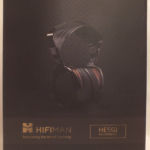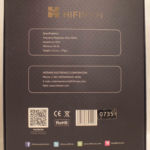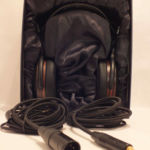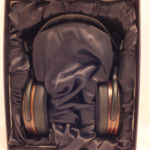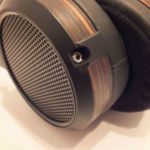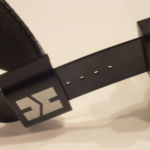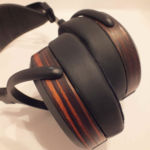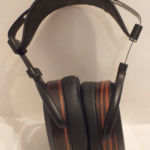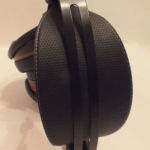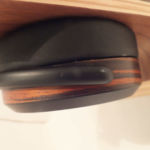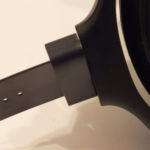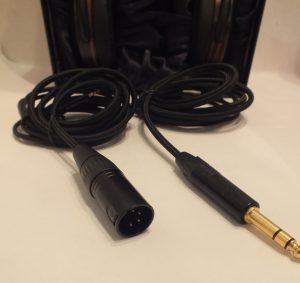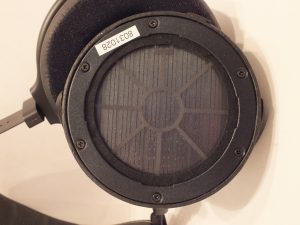Hifiman He560
disclaimer: The He560 is one of my personal collection and was purchased through retail channels. I have no affiliation with Hifiman or any of its distributors.
Unboxing / Packaging:
The He560 packaging has changed over the years and mine has the newer style slip-cover design with the hard case. The case is a lift top design hinged on the narrower edge. Padding is good with satin cloth over the padding and a formed indention for the headphone (one caveat, the headband must be in its shortest position to fit) and a central compartment for the provided cables. Cables have also changed during the production time of the He560 and this model has the 2.5mm connectors at the cups. Cables are provided for 6.3mm and XLR connections. Overall, the packaging and case is in-line with expectations of gear at this price point.
Build/Fit:
One cannot realistically discuss the He560 without mentioning the hardware. While the original design is comfortable enough, it isn’t super durable and sooner or later the gimbals will break. Hifiman sells a newer version of the assembly for $75 but will not sell the individual parts so if purchasing an early He560, it is wise to allocate the additional funds to purchase the updated furniture as the originals are fragile at best. The newer style hardware does little to change the comfort level as the wide band and lack of weight goes a long way toward keeping the He560 from causing pressure points. Clamping force is solid, but not so much so that wearing them with glasses is uncomfortable. Pads have also evolved with the current version having a slight forward angle so the rear of the pad is wider than the front. (It is worth noting that the He560 is particularly sensitive to pad swaps and installing a different type of pad will likely impact the sound signature). Cups rotate on the Vertical axis from just below the headband adjustment point and on the horizontal from the connector at the middle of the cup to allow for a proper fit on nearly everyone.
Cables:
Having had several He560s over the years (yes, I’m a fan) I can tell you I much prefer the current design to the original. Early models required that you screw the connectors on and off at the cups and were not particularly sturdy. Switching to a slightly forward angled 2.5mm mono connector has improved the easy of use and made it more robust at the same time. The cloth wrapped cables are reasonably pliable, but the He560 is designed for sedentary use so microphonics are not really an issue anyway. If you are purchasing the He560, I highly recommend purchasing the He Adapter to be able to use a Receiver or Stereo Amplifier with them. Granted, plenty of headphone amplifiers exist today that are capable of driving the He560, but there is something satisfying about running them off the more potent two channel components.
Internals:
Hifiman is notorious for not releasing a lot of detailed information about their drivers, and the He560 is no different. What little information is available is the stator is single sided and nearly the full size of the cups. (The single sided stator reduces the magnet count and weight compared to earlier models and thus the drop in weight from the 500 gram range of He6 to the listed 375 grams for the He560). Note that design update (wood to laminate, headband updates, and connector changes will all alter that weight number slightly). Nominal Impedance is listed at 45Ω on the Hifiman site with a sensitivity of 90dB/mW. As with most of the higher end Hifiman headphones, the sensitivity numbers should be taken with a grain of salt. The He560 likes power and lots of it. These are not the headphones for use with a cell phone or tablet and even smaller amps are not likely to get the He560 to perform. For purposes of this review, I used the Burson Swing, and either the Fun with the 6.3mm cable or the Bang and a He adaptor with the XLR cable. Either of these combos are capable of really driving the He560 properly.
Sound:
As previously mentioned, sound is very dependent on which pads are in use. For purposes of this discussion I used the factory pads. For personal listening, I prefer the Dekoni Elite Velour as I found the Sheepskin tends to push the bass a bit forward by comparison.
Bass:
The Planars as a class are known for excellent bass both in extension and in quality of delivery and the He560 certainly fits this description. Bass is not forward of the rest of the signature but manages to deliver a visceral impact when called for. Sub-bass rolloff is well down into the 20Hz range with only the LCD series having more bass depth with similar control. Mid-bass has very good texture and detail with speed of attack and decay keeping everything well controlled and tight. Timpani and kick-drum are both well rendered and very natural. Overall, tight, clean, and natural are the words that best fit the low-end.
Mids:
I love mids, if you have read any of my reviews you likely already know this. The He560 is one of my personal favorites for relaxed listening. That should likely tell you all you need to know. Mids are indeed the highlight of the He560 for me as timbre is spot on and the He560 seems to effortlessly produce guitars and strings and even piano which is a very tough task. When paired with the right amplifcation, the Mids on the 560 are as good as I have heard short of something like the Stax009 or He6 which puts it in good company. Voices are well rendered regardless of gender and again textures are amongst the best I’ve heard. To my ear, the He560 has an odd knack for being able to make vocals cut through the rest of the instrumentation without feeling like they are forward and in your face. Its a neat trick and one I really appreciate.
Treble:
Treble walks the very thin line between sounding overly energetic and sounding dull. Extension is very good with excellent detail. Cymbals sound realistic as does the hi-hat without becoming metallic or tizzy. Unlike the HD700 that I compare a bit later, the He560 doesn’t have the tendency toward stridency and only produces sibilance if it is embedded in the source recording. To me the treble on the He560 sounds a bit like the HD800 albeit with a shade less detail.
Soundstage / Imaging:
Stage on the He560 is both broad and deep with a good sense of height. I would categorize it as behind the HD800 at the very top and ahead of the rest of the HD line. Stage is similar to the LCD-3 I recently tried in both width and height and only very slightly smaller in depth. Imaging is very accurate and makes it easy to seat the orchestra based on what you hear. Layering follows suit with good instrument separation and above average clarity. I think some of the reason for the clarity of the He560 is its speed. Attack and Decay are laser sharp and exceed some models at higher price points including the LCD-3. This may be due to the single sided design of the stators in the He560, but for whatever reason its speed is second only to Stax. The only drawback to this speed is the fact that sometimes a little sustain in the decay is needed for warmth.
Comparisons:
Comparisons are hard to pick for the He560 due to price fluxuations. Originally the He560 was nearly $1000 headphone, more recently it has dropped substantially and has been on sale for closer to $600 than $1000. Used pairs can almost always be had for $350 or so. For that reason, these comparisons my seem a bit random as some are closer to the original price point and others nearer the used price.
Sennheiser HD Series
The He560 falls between the HD700 and HD800 in price (both new and used) and also between the two in sound quality. Bass is better on the He560 than either the HD700 or 800 particularly sub-bass. To my ear, the farther you go up, the more the 800 pulls away. Mids are good on both, but a shade more detailed on the 800, Treble is better extended on the 800 and more detailed although I’m not sure the casual listener would ever notice the differences. When comparing to the 700, the He560 outclasses it on both ends, while the 700 holds its own on mids. To me, acoustic guitar sounds a bit more natural on the HD700 while electric guitar sounds better on the He560. Sound-stage also splits the difference between the HD700 and HD800 and while not as expansive as the HD800, it comes closer to it than it does to the HD700. The biggest advantage of the HD700 is that it is much easier to pair than the He560 and can be used with lower powered sources.
Beyerdynamic T90
The T90 build is a bit more solid than the He560 as most of it is metal vs plastic in the He. That does mean the T90 feels a bit heavier on the head when worn for long periods. Both are near neutral signatures but the T90 rolls-off a bit further up than the He560 on the low-end and has less bass impact by comparison. You hear bass on the T90, you feel it on the 560. Both have great control all the way from end to end. Mids are better on the 560 as the T90 still has some of that recess that Beyer is somewhat famous for. Highs are good on both but to my ear the T90 is a bit more lively with a bit more top end air. Both have expansive sound stages, but hear again the T90 is larger while the 560 is a bit more Holographic.
Audeze EL-8 Open
Starting at the low end, bass is almost equally well controlled on the EL-8, but nowhere near as present and to me, the EL-8 comes off as bass-shy while the He560 is more neutral. Mids are a closer match with the EL-8 being a bit warmer while the He560 is slightly more detailed. The EL-8 also seems to push vocals a bit more forward when compared to the He560 and sounds a bit more intimate but smaller staged as a result. Treble is very good on both and again is seperated by a matter of degrees. The He560 is slightly more detailed, while the EL-8 comes off as slightly brighter. Build on the EL-8 is considerably more solid with its intended target audience being mobile use.
AKG K-702
Perhaps more similar than not in that both need substantial power and drive to really do their best work, neither of these two can be considered easy to drive. Weight is considerably less on the K-702 vs the He-560 so it may be more comfortable for long-term wear. Both are near neutral tunings but the K-702 rolls off earlier at both ends and has a bit more mid emphasis than does the He560. Details are good on both, but better on the He560. To me sonically, the He560 is an improved K-702. Also worth noting is the K-702 needs a long break in period to really sound its best. Comparing a new out of the box K-702 to anything is an injustice to the K-702 as they usually sound screechy at first.
Thoughts / Conclusion:
In defining the He560, I kept finding myself using words like clean, deep, clear, sharp, effortless, and realistic. Overall, not a bad combination of choices. The drawbacks are big power requirements, and limited use-cases as this isn’t anyone’s idea of a portable. Within its limitations, it may well be the best headphone you can buy from a value perspective. It offers sound quality very near what the bigger Hifiman, Audeze, and even the vaunted HD800 for a price tag much lower. If you can find one used, the proposition gets even more slanted toward value. (Just remember to set aside $75 for the new headgear). Overall if you have $1000 to spend on a system and you like the planar sound, I think few systems would better the Burson Playmate paired to the He560. I recently had the He6se to review and while it is definitely a step up from the He560, I must admit for my own spend, the law of diminishing returns comes into play and I would seriously question whether there is $1500 more value in a He6se vs a used He560.
-
Bass - 7.5/107.5/10
-
Mids - 7.5/107.5/10
-
Treble - 7/107/10
-
Soundstage - 8/108/10
-
Imaging - 8/108/10
Summary
Pros: When given the power it needs, few headphones can top it.
Cons: Requires big power to really do its best work


